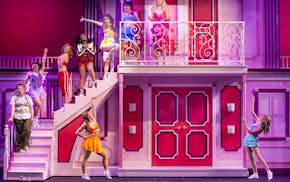If you want to sum up everything some people hate about the suburbs and the early days of sprawl, two words will do.
Strip mall.
Charmless, ugly, unadorned, surrounded by acres of baking asphalt. The people who patronized them in the post-World War II era, though, had another term. They called them "shopping centers," before the term came to mean enclosed malls. And people liked them. They offered ease and convenience close to home. The style of the malls was irrelevant. They were the trading posts on the new frontier.
But now, decades later, they're unloved as a concept, and many strip malls around the metro area struggle to keep the storefronts filled. How can they be improved? And was there anything they could've done when they were built to make them look and function better?
First, a little history.
For the people who filled the burgeoning 'burbs, the strip mall was a distinct improvement over shopping downtown .No waiting for the streetcar, no pay-to-park, no running from block to block to get what you needed. The early strip malls often had a grocery store as an anchor. There was a drugstore for prescriptions, notions, soap, a greeting card. A variety store might supply socks or parakeet food. A shoe store, a clothing store, a beauty parlor — all in one place, a concentrated, manufactured main street with parking galore.
At the time, no one really cared how the malls looked. The old downtown department stores had vied with each other to build the most interesting temple of commerce, hoping to lure followers from the competition. They had a sense of civic duty, adding their facades to the historical tapestry of the streetscape. The strip malls had no such obligations. They were utterly efficient. Beauty didn't matter.
What counted was parking. Almost from the start, that was a draw — and a problem.
At the top of a full-page Minneapolis Tribune ad for the Holly Shopping Center in Fridley, 1959: "Acres of Free Parking."
Didn't that go without saying? Not exactly. A 1953 Minneapolis Tribune story about the shopping center boom noted the growing pains:
"Shopping center developers always emphasized the need for adequate parking, but many have found they underestimated the amount of space they would need with the increase in the number of automobiles. Now some of the older centers are losing business because of a scarcity of parking space and traffic jams that are as bad as those in the loop during rush hours."
As the lots got bigger, the stores moved farther away from the street. And shopping malls eventually became a blot on the suburban landscape, because they made one crucial design mistake: The lots, not the stores, faced the street.
If they'd flipped the script and built the stores close to the street, and tucked the parking behind, suburban intersections would look denser, more interesting and much more inviting.
Many of the shopping centers survive, because they're useful. Most have been upgraded and rehabbed over the years, for good or ill. There are three basic styles of improvement:
Refresh it
Texa-Tonka (8000 Minnetonka Blvd., St. Louis Park) has been updated, the billboards have been removed and the buildings have been painted black. It now looks sleek and modern.
Centennial Lakes Plaza (7500 France Av. S., Edina) was, and is, one of the great offenders of parking-first designs. It looked nice on paper: a street (the imaginatively named Plaza Drive) leading from France Avenue to two glass octagonal stores, flanking a pavilion on the shores of the manmade lake. But you couldn't see any of that from the street. What you saw was a depressing sea of asphalt with the obligatory low-slung strip mall in the distance.
Now it's a tasteful gray. Bright and clean. It'll look old and dated in 20 years, so they'll have to blast off the paint, and everyone will swoon at the natural look.
Dress it up
Also in the Southdale area, you'll find the Rue de France (7010 France Av. S.). They mean "rue" as in "street," but you could also say "rue" as in "regret." They added precast slabs embossed with fleur-de-lis on the roof at various locations. Those flourishes have no connection to the jumble-of-stone pillars or the early '80s vertical-brick facade. It looks silly.
The Hub, a large shopping center in Richfield (66th Street and Nicollet Avenue S.), put up a brick tower bearing the center's name. It has a '90s vibe, and makes the place look like a neighborhood landmark. But the empty hulk of the nearby long-gone Rainbow grocery store and its windswept empty parking lot make the strip mall seem a bit bereft.
Use lots of stone
This might be the most popular way to humanize the old strip malls and make them seem rustic and classy. The Miracle Mile in St. Louis Park (Excelsior Blvd. and Hwy. 100), one of the first postwar shopping centers, has a stone facade with stone pillars, with a faux-clay tile roof. It looks like a country lodge, or rustic cabin. It's better looking than others, perhaps, but no one thinks the strip malls are really made of stone.
As efficient as strip malls once were — and still are, in some cases — the best use for many of the aging shopping centers might be demolition and replacement with housing. The Holly Center (Mississippi Street and University Avenue NE.) has been replaced by a four-story residential complex that tucks the parking lot behind the apartments, out of sight. If this is the eventual fate of the weary old strip malls, the ground floor of the new residential complexes should be devoted to retail.
Imagine that: shops on the ground floor, apartments above. An idea as old as cities.
Previous versions of this story misstated the status of the Valley Ridge strip mall in a photo caption.

For 'Legally Blonde' star, 'being underestimated is her secret superpower'

Restaurant openings and closings in the Twin Cities

Minnesota's Amy Thielen launches old-fashioned radio show for food lovers
Yuen: How success has pushed Minnesotans off sidelines in trans athlete debate

